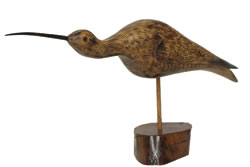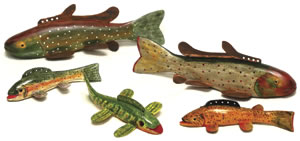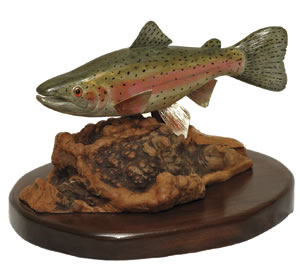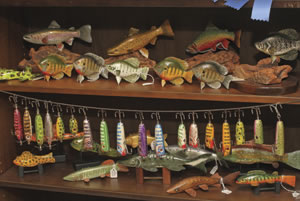Ron Dombrowski started carving one day when his wife told him to "go downstairs into the cellar and do something!" His trip down the steps was a journey to a new way of expressing the love for the outdoors that has guided his aspirations for most of his life. His affection for hunting and fishing had yielded professional occupations training hunting dogs, judging field competitions, managing hunting clubs and a sporting clay range. Now, with time on his hands, Dombrowski began to read and dabble.
Go downstairs to Ron's basement today and you'll see various band and table saws, a lathe, bins full of cedar and white pine, racks full of tubes of paint, and a vast array of screws, rivets, and odds and ends. Everywhere there are books, mostly written for collectors, a reference for an art form that captivates countless outdoor lovers and fine craft aficionados.

Upstairs in the Dombrowskis' Stockton home, dozens of shelves hold the consequence of Ron's study. Birds dominate one side of the room: full size and miniatures, some decorative doves, and owls made from a hundred-year-old piece of cedar from the old bridge keeper's house at Long Beach Island. Traditional shore bird gunning decoys dominate, with some interesting variations on the classic shore bird "stick up", the familiar muted tones on a contemporary shape. "It's called carving, but painting is just as important," says Ron. "Learning the paint was the hardest part. The mute colors are very challenging, but people like the plain, earthy look." Since shore bird hunting was outlawed in the 1920s, carvings have been for collectors only, some fetching upwards of a million dollars. Dombrowski's hobby, copying the styles of the great carvers from pictures in books, has found a market in local craft and gift shows. And, he has won first, second and third place at the Contemporary Shore Bird Contest in Tuckertown. "That judge liked my work. The next year I didn't even get a sniff."


Dombrowski has also won awards for his fish decoys. Still legal in five mid-western states, spearing decoys are useful in ice-fishing, where a dark house over a hole in the ice illuminates the decoy. "You swim it around in a circle, and the big fish come up after it." These decoys have also recently become collectible. "Another contest in Tuckerton judged on how the decoys swam, not how they looked. So I had to learn how to make them swim. You pour hot lead in the bottom weight them right, head up, tail down bend the fins, and use different line ties for different action. I took a few lessons. You make them as pretty as you want to." If pretty is what you want, Ron also has a full line of decorative fish. The colors are stunning, and the detail shows that he has come a long way with the "painting part."

The outdoorsman is always interested in function, as well as form. The mark of a master carver can be found in a decoy that simultaneously pleases the eye and fools Mother Nature. Is there a better test for function than a fishing lure? " I liked the way the old lures looked and everything now is made of plastic, so I carved these. The first one I made I caught two largemouth bass in an hour the first day I used it. Wow this sucker works!"
For more information, please email the artist.